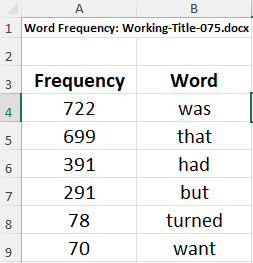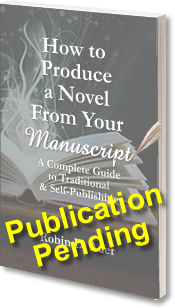
The 8 Steps to Produce a Novel
How to Produce a Novel from Your Manuscript, a Complete Guide to Traditional & Self-Publishing includes all the information on this website plus:
- How to use a Word Frequency Counter like an MRI to see inside your manuscript for elements that impact its health.
- How to find, qualify, and secure Beta-Readers, how to ensure they participate on your terms, and how to interview them after they’ve read your manuscript to extract essential feedback about your work.
- All the settings for your word processor to format your manuscript for publication on Amazon’s KDP.
- There’s more. See the Table of Contents to learn how this one book can help launch your manuscript.
I. The Hardest Journey: Walk Away!

Don’t read or even scan any part of your manuscript. Find something else to do for 30 days. If something pops into your mind about the draft, write it down and save it for the next step.
You likely have multiple ideas going on in your head, so start another manuscript. One full month!
You can’t edit the manuscript because you know it too well. You will read what you intended to write, not what hit the page, perhaps catching obvious errors but missing others. Experience proves that in a month your intimacy with the words will subside into familiarity and that’s when you can edit.
This is a time when Alpha readers—friends and relatives—may be allowed to read some or all of your work. Advise them that the manuscript is NOT edited and that you’re more curious about their impression of the story line, characters, etc., not grammar or punctuation.
II. A Slow, Deliberate Read

Okay, you made it 4 weeks. Close enough. While not essential, you’ll catch more errors if the manuscript is printed.
Find distraction free time to read the manuscript slowly and deliberately. Your personal Issues regarding “distraction free time” are beyond the scope of this discussion, but concentration is essential.
Read with pencil in hand. If working on a digital device or computer, preserve the original file and mark up corrections on a new copy. See “File Backup” to learn about saving generations of your work.
Don’t just move your focus across the words; read them. Circle anything more extensive than a punctuation or spelling error. Don’t rewrite poorly written dialog or paragraphs, yet. Mark them with a note to reconsider later.
If you find a paragraph, exchange of dialog, or exposition that doesn’t belong—perhaps you meant to delete it and didn’t—mark it for deletion and continue on. Same for repetitive dialog. But don’t do those corrections, yet.
Only after going through the manuscript do you go back to rewriting dialog and making deletions. Address typos, punctuation, and grammatical corrections in the new copy of the working file.
III. The Word Frequency Counter

The WFC is a miraculous tool largely unfamiliar to writers that supercharges your self-edit accomplishing many of the same goals as an experienced editor.
The power of the WFC is that it forces you to look at your words in a different way to find rough spots, unclear wordings, and constructions that are just plain wrong, highlighting errors that you won’t identify in a straight read-through.
There may be a hundred of these issues in your manuscript each slowing the reader who trudges through words, loses focus, and is hindered in their enjoyment which costs “stars” and invites lackluster reviews.
Step-by-step instructions for getting the most out of the Word Frequency Counter can be found in How to Produce a Novel From Your Manuscript.
IV. Rinse, Lather, Repeat

Not as brutal as last time, take a week off to let your palate clear. Take a nap.
Then do another slow, deliberate reading. You may be tempted to get creative. Don’t. Only if you stumble upon something that just doesn’t look right or find a grievous plot error, don’t begin a new round of writing unless you’re prepared to start over again.
V. Word Processor Review

Microsoft Word flags misspelled words by underlying them in red. Grammatical concerns are underlined in blue.
If you’re not using Word, your word processor will likely indicate potential errors similarly. Understand that the wisdom of the automated spell and grammar check is not perfect.
While you may have been addressing these issues throughout the previous exercises, now is the time to scan the full document correcting misspelling and grammatical errors and dismissing the system’s misidentifications.
VI. Read Out Loud!

Want to approach perfection in word choices, pacing, and balance? Read your manuscript out loud. If you trip over your own words, you know that others will stumble as they read.
You’re engaging another sense, your hearing, and processing your words through another part of your brain. You may find words or phrases that you don’t like, or immediately find better means of expressing your thoughts when you unconsciously say something that isn’t on the page.
While I’d suggest full chapters, nothing is lost by doing this chore when and where the opportunity arises in small or long bursts.
VII. Beta Readers

The job of the Beta Reader is not to be an editor but to provide feedback about the story, the plot, the characters, and the ease and enjoyment of the read as if they had purchased the book.
How to Produce a Novel provides four do’s and don’ts in qualifying Beta readers, where best to find those readers, offers a “Beta Reader Agreement,” and details how to interview the Beta Reader to extract the most comprehensive review of your manuscript. There’s a science to it and their contributions are free.
Beta Readers were an untapped resource as there was no wisdom detailing how to capture and apply their input. Now there is.
VIII. Seek Professional Help

The services of an editor, of course.
If you fastidiously follow the steps using the tools in How to Produce a Novel, you’ll have a relatively clean document, relative to 90+% of manuscripts most editors see. However, editorial analysis of the writing will improve the work.
When negotiating with an editor—and there’s always room for negotiation—offer a sample of your polished manuscript to demonstrate how far along the edit path you’ve brought the work. That should convince the prospective editor to discount their services because they won’t be scratching through corrections of lay/lie and misapplied semicolons. To seek the representation of an agent, this is essential.
If self-publishing, it’s a matter of budget. If you can afford it, have an editor do a full once-over to polish the writing.
Our services, are designed for the self-published author on a budget.
